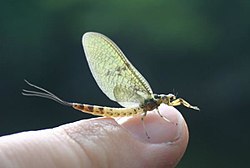蜉蝣
Jump to navigation
Jump to search
Chinese[edit]
| Ephemera strigata | |||
|---|---|---|---|
| simp. and trad. (蜉蝣) |
蜉 | 蝣 | |
| alternative forms | 浮游 浮蝣 蜉蝤 | ||
Etymology[edit]
(This etymology is missing or incomplete. Please add to it, or discuss it at the Etymology scriptorium. Particularly: “looks like there's some sort of reduplication”)
Pronunciation[edit]
Noun[edit]
蜉蝣
- mayfly
- 蜉蝣之羽、衣裳楚楚。 [Pre-Classical Chinese, trad. and simp.]
- From: The Classic of Poetry, c. 11th – 7th centuries BCE, translated based on James Legge's version
- Fúyóu zhī yǔ, yīshang chǔchǔ. [Pinyin]
- The wings of the ephemera, are robes, bright and splendid.
Derived terms[edit]
- 蜉蝣在世 (fúyóu zàishì)
Descendants[edit]
Japanese[edit]

Etymology 1[edit]
| Kanji in this term | |
|---|---|
| 蜉 | 蝣 |
| かげろう | |
| Hyōgaiji | Hyōgaiji |
| jukujikun | |
| Alternative spelling |
|---|
| 蜻蛉 (obsolete) |
Change in meaning from 陽炎 (kagerō, “heat haze, heat shimmer”), from the way that the insects fly in swarms that visually resemble heat haze.[1] The kanji is jukujikun (熟字訓), from Chinese 蜉蝣 (fúyóu).
Pronunciation[edit]
- (Tokyo) かげろー [kàgéꜜròò] (Nakadaka – [2])[2][3]
- (Tokyo) かげろー [kàgéróó] (Heiban – [0])[2][3]
- IPA(key): [ka̠ɡe̞ɾo̞ː]
Noun[edit]
蜉蝣 or 蜉蝣 • (kagerō) ←かげろふ (kagerofu)?
Usage notes[edit]
- As with many terms that name organisms, this term is often spelled in katakana, especially in biological contexts (where katakana is customary), as カゲロウ.
Idioms[edit]
Idioms
- 蜉蝣の命 (kagerō no inochi): “a mayfly's life” → a metaphor for a short life
Etymology 2[edit]
| Kanji in this term | |
|---|---|
| 蜉 | 蝣 |
| かぎろう | |
| Hyōgaiji | Hyōgaiji |
| irregular | |
| Alternative spelling |
|---|
| 蜻蛉 |
Change in meaning from 陽炎 (kagirō, “heat haze, heat shimmer”), from the way that the insects fly in swarms that visually resemble heat haze.[1]
Obsolete reading.
Pronunciation[edit]
Noun[edit]
蜉蝣 • (kagirō) ←かぎろふ (kagirofu)?
Etymology 3[edit]
| Kanji in this term | |
|---|---|
| 蜉 | 蝣 |
| ふ Hyōgaiji |
ゆう Hyōgaiji |
| on’yomi | |
From Middle Chinese 蜉蝣 (MC bjuw yuw). Compare Mandarin 蜉蝣 (fúyóu), Vietnamese phù du.
Pronunciation[edit]
- (Tokyo) ふゆう [fùyúú] (Heiban – [0])[2]
- (Tokyo) ふゆう [fúꜜyùù] (Atamadaka – [1])[2]
- IPA(key): [ɸɯ̟ᵝjɯ̟ᵝː]
Noun[edit]
- a mayfly
- (by extension) ephemerality (from the way that mayflies are born and die within a day)
Idioms[edit]
Idioms
- 蜉蝣の一期 (fuyū no ichigo): “a mayfly's life” → a metaphor for a short life
References[edit]
- ↑ 1.0 1.1 “蜉蝣・蜻蛉”, in 日本国語大辞典 (Nihon Kokugo Daijiten, “Nihon Kokugo Daijiten”)[1] (in Japanese), concise edition, Tōkyō: Shogakukan, 2000
- ↑ 2.0 2.1 2.2 2.3 Matsumura, Akira, editor (2006), 大辞林 (in Japanese), Third edition, Tōkyō: Sanseidō, →ISBN
- ↑ 3.0 3.1 NHK Broadcasting Culture Research Institute, editor (1998), NHK日本語発音アクセント辞典 [NHK Japanese Pronunciation Accent Dictionary] (in Japanese), Tōkyō: NHK Publishing, →ISBN
Vietnamese[edit]
| chữ Hán Nôm in this term | |
|---|---|
| 蜉 | 蝣 |
Noun[edit]
蜉蝣
Adjective[edit]
蜉蝣
Categories:
- Mandarin terms with homophones
- Middle Chinese lemmas
- Old Chinese lemmas
- Chinese lemmas
- Mandarin lemmas
- Cantonese lemmas
- Hokkien lemmas
- Teochew lemmas
- Chinese nouns
- Mandarin nouns
- Cantonese nouns
- Hokkien nouns
- Teochew nouns
- Chinese terms with IPA pronunciation
- Literary Chinese terms with quotations
- Chinese disyllabic morphemes
- zh:Insects
- Japanese terms spelled with 蜉
- Japanese terms spelled with 蝣
- Japanese terms read with jukujikun
- Japanese terms spelled with jukujikun
- Japanese terms derived from Chinese
- Japanese terms with IPA pronunciation
- Japanese lemmas
- Japanese nouns
- Japanese terms with multiple readings
- Japanese terms spelled with hyōgaiji kanji
- Japanese terms written with two Han script characters
- Japanese terms with obsolete senses
- Japanese terms with irregular kanji readings
- Japanese terms read with on'yomi
- Japanese terms derived from Middle Chinese
- ja:Insects
- Vietnamese lemmas
- Vietnamese nouns
- Vietnamese nouns in Han script
- Vietnamese Chữ Hán
- Vietnamese adjectives
- Vietnamese adjectives in Han script

